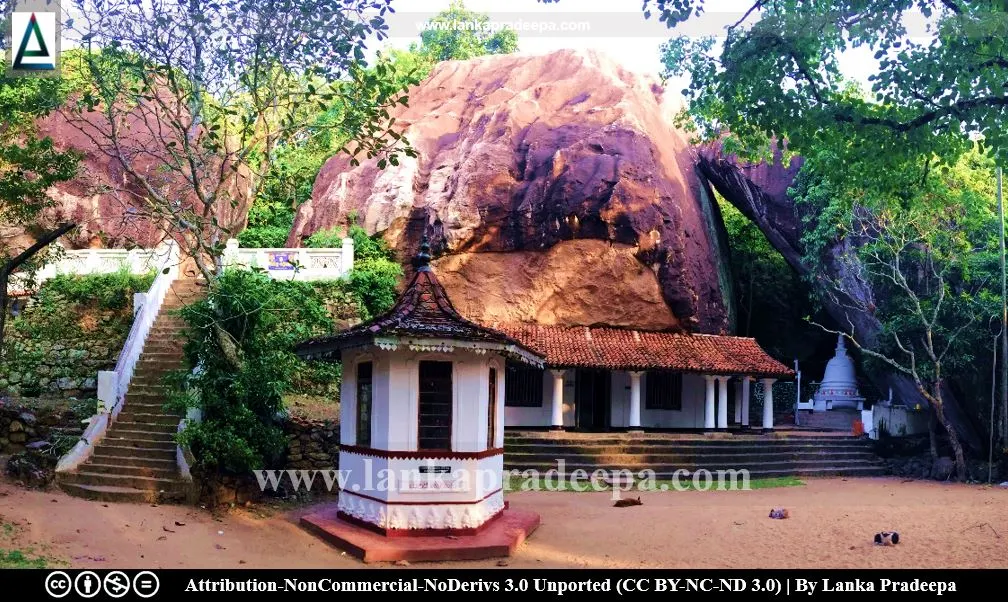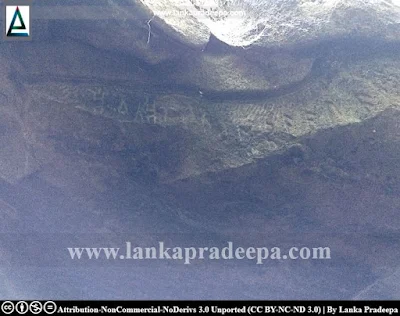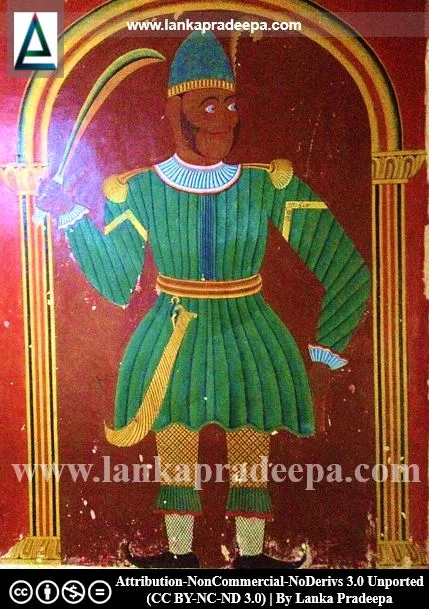
Pilikuththuwa Raja Maha Viharaya (Sinhala: පිළිකුත්තුව රජ මහා විහාරය) is a cave temple located in Pilikuttuwa village near Yakkala town in Gampaha District, Sri Lanka. The site can be reached by travelling along the Yakkala - Radawana road about 3.4 km distance from the Yakkala junction.
History
The history of the Pilikuttuwa temple expands from the Prehistoric Period to the Kandyan Period (Jayarathne & Gunawardhana, 2017). Archaeological evidence dating back to the prehistoric period has been found in several caves located on the site. Early Brahmi Inscriptions found in some caves indicate that this area was in existence as a Buddhist religious place since the pre-Christian era. Also, the cave temples such as Uruwala, Maligathenna, Varana, Miriswatta, and Koskandawala those situated in the vicinity of Pilikuththuwa Viharaya are said to have formed one major cave site during the early part of the Anuradhapura Period.
Locals link the history of this temple to King Valagamba (103, 89-77 B.C.). It is said that the king used this site as a hideout during the reign of the Five Dravidians (five Indian invaders who ruled the Anuradhapura Kingdom from 103 to 88 B.C.).
The Cave Temple
The main cave temple of Pilikuttuwa Viharaya is said to have been constructed in 1747 by Sonuththara Thera, a student monk of the erudite Buddhist monk Weliwita Sri Saranankara Thera (1698-1778 A.D.) who is considered the pioneer of the revival of Buddhism on the island in the 18th century.(Dissanayaka, 2023). The paintings on the ceiling and the murals on the walls belong to two periods and the guardian images of Portuguese soldiers are said to have been repainted in 1894 (or 1874) by an artist named Mangala Heriyen Siriya (Dissanayaka, 2023).
Inscriptions
Four cave inscriptions written in early Brahmi characters have been found at the site. Three of them are published by Senarath Paranavitana in 1970 (Paranavitana, 1970).

Pilikuttuwa cave inscription of Aggibhuti
Period: 3rd century B.C.- 1st century A.D.
Scripts: Early Brahmi
Language: Old Sinhala
Transcript: Anikatasa batuno Agibutino dane
agata anagata chatudisa sagasa
Content: This inscription records that the cave
of Aggibhuti, the brother of Cavalry officer has
been given to the Sangha of four quarters
present and absent.
Reference: Paranavitana, 1970.
The Temple Complex
A large number of caves with or without drip ledges have been identified on the temple premises. The small Stupa, surrounded by a large drip-led cave, was built during the Kandyan period and had been sheltered with a roof. Other monuments such as the ancient cave temple with paintings of the Kandyan period, three-storied preaching hall, roads, and the mould creeper (Pus Wela) with a perimeter of 6 feet (which is believed to be about 400 years old) have increased the historical value of the temple.
The pond made with cairus of stones, the underground water canal, the wooden bridge, and the ancient reservoir are also considered important monuments found within the temple premises. The wooden bridge has been constructed across the underground water channel that runs between the pond and the reservoir during the Kandyan period.
A Protected Site
The ancient image house, all the caves, cave inscriptions, monks' dwelling houses, Stupa, Diggala, Dewala Lena, wooden bridge, pond, and the Dharmasala (the preaching hall) within the premises of Pilikuththuwa Rajamaha Vihara situated in Grama Niladhari Division of Pilikuththuwa in the Divisional Secretary’s Division Mahara are archaeological protected monuments, declared by the government gazette notifications published on 1 November 1996, 22 November 2002 and 7 July 2016.




See Also
#) Historical and Memorial Trees in Sri Lanka
References
1) Dissanayaka, S. B., 2023. 2015 Varshaya Sandaha Puravidya Generalge Palana Varthawa (In Sinhala). Department of Archaeology. ISBN: 978-624-5840-24-3. p.63.
2) Jayarathne, H.A.S.N.; Gunawardhana, K.K.H.M., 2017. පිළිකුත්තුව රජමහා විහාරයේ සිතුවම්, සෙල්ලිපි හා ආවාස සම්ප්රදාය පිළිබඳ අධ්යයනයක් [A study on the paintings, inscriptions and dwelling tradition of Pilikuttuwa Raja Maha Viharaya (In Sinhala)]. Undergraduates' Research Conference on Archaeology, Tourism and Cultural Resource Management (URCAT), Department of Archaeology, University of Kelaniya, Kelaniya. p.35.
3) Paranavitana, S., 1970. Inscription of Ceylon (Vol. I). Department of Archaeology Ceylon. p.86.
4) The Gazette of the Democratic Socialist Republic of Sri Lanka. No: 948. 1 November 1996.
5) The Gazette of the Democratic Socialist Republic of Sri Lanka. No: 1264. 22 November 2002.
6) The Gazette of the Democratic Socialist Republic of Sri Lanka: Extraordinary. No: 1974/16. 7 July 2016. p.5A.
Explore Other Nearby Attractions
Responsive esri Map
Responsive Google Map
පිළිකුත්තුව රජමහා විහාරය
පිළිකුත්තුව රජමහා විහාරය ශ්රී ලංකාවේ ගම්පහ දිස්ත්රික්කයේ පිළිකුත්තුව පිහිටි බෞද්ධ සිද්ධස්ථානයකි.
ඉතිහාසය
පිළිකුත්තුව විහාරයෙහි ඉතිහාසය පූර්ව ඓතිහාසික යුගයේ සිට නුවර යුගය දක්වා විහිදෙයි. මෙහි පිහිටි සමහරක් ලෙන් වලින් පූර්ව ඓතිහාසික යුගයට අයත් පුරාවිද්යාත්මක සාධක හමුව තිබේ. සමහරක් ලෙන්වල වන පූර්ව-බ්රාහ්මී සෙල්ලිපි මෙම ස්ථානය ක්රිස්තු පූර්ව යුගයේ සිටම ආගමික ස්ථානයක් වශයෙන් පැවති බව තහවුරු කරයි.
පිළිකුත්තුව විහාරයට ආසන්නව පිහිටි අනෙකුත් ලෙන් විහාර වූ ඌරුවල, මාළිගාතැන්න, වාරණ, මිරිස්වත්ත හා කොස්කඳවල යන විහාර අනුරාධපුර මුල් අවධියේදී එකම විහාර සංකීර්ණයක් වශයෙන් පවතින්නට ඇතැයි සැළකේ.
ජනප්රවාද
දකුණු ඉන්දියානු ආක්රමණිකයන් විසින් අනුරාධපුර පාලනය කරන සමයේ වලගම්බා රජු මෙම ස්ථානය භාවිත කල බව ජනප්රවාදයේ සඳහන්ය.
විහාර සංකීර්ණය
කටාරම් සහිත හෝ රහිත ලෙන් විශාල සංඛ්යාවක් (99ක් පමණ) මෙම විහාර පරිශ්රයෙන් හමුව තිබේ. විශාල කටාරම් සහිත ලෙනකින් වටවූ කුඩා ස්තූපය අතීතයේ වහළයකින් ආවරණය වී තිබුණි. නුවර යුගයට අයත් සිතුවම් සහිත ලෙන් විහාරය, ධර්මශාලාව, මං පෙත්, අඩි 6ක වටප්රමාණයෙන් යුත් වසර 400ක් පැරණි යැයි විශ්වාස කෙරෙන පුස් වැල, විහාරයේ ඓතිහාසික බව වැඩිකරන අනෙකුත් ස්මාරක වෙයි.
සක්ක ගලින් නිර්මිත පොකුණ, භූගත ජල මාර්ගය, පැරණි දැව පාලම, හා පුරාණ වැව ද විහාර භූමියෙහි හමුවන වැදගත් ස්මාරක වේ.
පුරාවිද්යා ස්මාරක ස්ථානය
පිළිකුත්තුව රජමහා විහාර පරිශ්රයේ පිහිටි පැරණි විහාර ගෙය, සියළුම ලෙන්, ලෙන් ලිපි, භික්ෂු කුටි, ස්තූපය, දිග්ගල, දේවාල ලෙන, දැව පාලම, පොකුණ, සහ ධර්ම ශාලාව, 1996 නොවැම්බර් 1 වන දින හා 2002 නොවැම්බර් 22 හා 2016 ජූලි 7 වන දින ප්රකාශයට පත් රජයේ ගැසට් නිවේදන මගින් ආරක්ෂිත පුරාවිද්යා ස්මාරක ලෙස නම් කොට ඇත.

